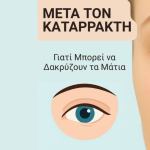
Introduction
Modern ophthalmic surgery has revolutionized vision: cataract, LASIK, lens implants, corneal transplants.
Yet, many patients complain of dry eye, tearing, or unstable vision after surgery.
The problem is not the surgery — it is the ocular surface on which the surgery relies.
The “Ground” of Surgery – The Ocular Surface
The ocular surface is the soil.
Even the best seed won’t grow in damaged ground.
- If the eyelids/eyelashes have chronic inflammation, bacteria, Demodex or Meibomian gland dysfunction → the result of the surgery is undermined.

Cataract Surgery
- Most common eye surgery worldwide.
- Studies show that neglected eyelid hygiene leads to postoperative discomfort, tearing, and allergic symptoms.
- Hygiene before & after reduces complaints.

Evidence:
- 70–80% of cataract candidates have dry eye or blepharitis.
- 50% show MGD pre-op.
- In LASIK, pre-op dry eye doubles post-op symptoms.

LASIK & Refractive Surgery

LASIK is the world’s most common refractive surgery —
and it has a Greek origin
Professor Ioannis Pallikaris from the University of Crete is internationally recognized as the “father of LASIK”. His innovation transformed ophthalmology, giving millions the gift of glasses-free vision.
But even LASIK needs a clean surface:
- Untreated blepharitis = worse dry eye after.
- Healthy eyelids = stable and comfortable vision.
Lens Implants (ICL, Multifocal)
- Require pristine ocular surface.
- Inflammation or Demodex cause hazy vision.
- Hygiene pre-op improves satisfaction.
Corneal Transplant
- The graft needs a sterile, healthy environment.
- Hygiene lowers infection risk and graft rejection.


Aesthetic Impact
Beyond vision, patients want beautiful eyes.
Blepharitis causes dark circles, swelling, tired look. Hygiene improves both health and aesthetics.

Dermophthalmology’s Solution
Daily hygiene is the “invisible 50%” of success:
- Ophthalmogen EYE10 thermotherapy to decongest glands, restore their healthy function, and improve refractive ability by improving the quality of your own tears.
- Naviblef foam for daily morning cleansing of the eyelids with lukewarm water
- Ophthalmogen Spray for spraying the eyelids/eyelashes when we are outdoors, in front of screens and for controlling Demodex
- Ophthalmogen Gel massage on the eyelids to relieve the eyelids, strengthen the eyelashes and improve blood circulation in the area.
- Artificial tears for daily hydration in the form of eye drops and sprays such as Flora Vision Spray
Case Studies
- Cataract: patient with tearing → improved with spray & gel.
- LASIK: young patient with dry eye → stabilized with EYE10.
- Corneal transplant: risk of infection → stabilized with hygiene.
FAQ
- Why is hygiene important before/after surgery?
Because a healthy ocular surface ensures better outcomes and fewer complications.
- Can blepharitis affect LASIK;
Yes, it increases dry eye and reduces visual quality.
- What is the best care routine?
Cleansing, spray, gel, thermotherapy, hydration.
- Do I need medical guidance?
Always. The surgeon is the ally; hygiene is the daily weapon.
Conclusion
Greece gave the world the “father of LASIK”.
Today, Dermophthalmology continues this legacy, showing that eye hygiene is the hidden half of surgical success.
Surgery gives vision. Hygiene gives comfort and longevity.
Dermophthalmology is the new medical specialty we have introduced (learn more at www.dermophthalmology.com)








